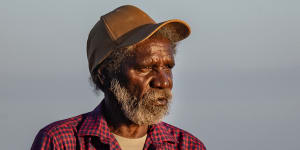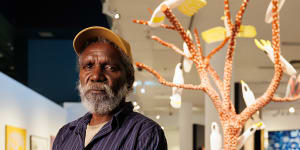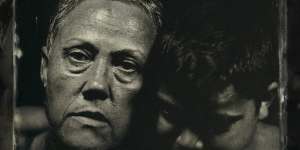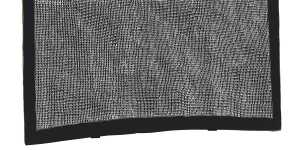It’s all just as the title,Ku’,Theewith&Kalampang:The White Cockatoo,Galah andthe Wandering Dog, suggests,but there is more to Wikmunea’s work,which has just won the $100,000 Telstra Art Award,the top prize at the National Aboriginal and Torres Strait Islander Awards (NATSIAA).

Aurukun artist Keith Wikmunea has won the top prize at the National Aboriginal and Torres Strait Islander Art Awards.Brian Cassey
There are layers of meaning inscribed in this yuk thanchal (milkwood) sculpture. Materially rooted in Aurukun,the timber and the ochre were sourced on Country. Wikmunea says yuk thanchal has been used since the “beginning of time” by his ancestors.
The red ochre with white dots (the artist made these with his finger) that wraps the tree recalls body painting designs used by Wikmunea’s clan,Apalech.

Keith Wikmunea with his work Ku’,Theewith& Kalampang:The White Cockatoo,Galah and the Wandering Dog.Charlie Bliss
The birds are his Puulwuy (father’s totem) and Kathwuy (mother’s totem). And the wandering dog has a songline,showing Indigenous cultural practices have always had ways to make sense of novel phenomena.
The Papunya Tula painters conveyed Indigenous aesthetic traditions in new ways when they adopted acrylic painting. Part of this story is Kumantje Jagamara (known also as Michael Nelson,1946-2020),who took the first National Aboriginal Art Award home in 1984. One of this year’s judges,Dr Peter Yanada McKenzie is someone who has been a part of this history – he was a judge along with Wandjuk Marika in the awards’ inaugural year.
In the four decades since the awards were founded at the Museum and Art Gallery of the Northern Territory by Franchesca Cubillo and Margie West,a lot has changed. The director of the gallery Adam Worrall tells me about the awards’ genesis at a time when Indigenous art was under-acknowledged in Australia. In 2023,Indigenous art is undeniable:its market value,exhibition history,aesthetic impact and capacity to change the way we see the world make it one of the country’s most significant art movements.
The Wandjuk Marika Memorial 3D Award is a broad category spanning everything from fibre and textile works,to sculpture and painted memorial poles,to ceramics. Anne Nginyangka Thompson has won it this year withAnangu History,two intricately detailed ceramic vessels that depict Anangu history.
Extending across the continent and a breadth of artistic practice,other category winners this year include Julie Nangala Robertson,who won the General Painting Award withMina Mina;Jimmy John Thaiday who won the Multimedia Award with Just Beneath the Surface;and Dhalmula Burarrwanga,who won the Emerging Artist Award withwanha,dhika,nhawi?.

Brenda L Croft’s blood/memory:Brenda& Christopher II (Gurindji/Malngin/Mudburra;Mara/Nandi/Njarrindjerri/Ritharrngu;Anglo-Australian/Chinese/German/Irish/Scottish)Brenda L. Croft
In an award with 63 artworks that represent 47 language groups (although the proceedings and the didactics are still predominately presented in English),memory,which is to say the embodied psychic process of making sense of the past,emerges as a key theme.
Winner of the Work on Paper Award,Brenda L. Croft’sblood/memory:Brenda&Christopher II(Gurindji/Malngin/Mudburra;Mara/Nandi/Njarrindjerri/Ritharrrngu;Anglo-Australian/Chinese/German/Irish/Scottish) is at once an intricate portrait of kinship and an act of linguistic activism.
The title disrupts the general desire to make indigeneity a static singular concept. In this self-portrait with her son/nephew,memory,blood memory,is held in the bodies of the artist and her son/nephew (the fact of Indigenous presence) and the relationship between the two (lived Indigenous kinship).
Memory and kin as the basis for artistic practice is a theme that cascades through the work of Kuninjku artist Owen Yalandja,whoseNgalkodjek Yawkyawk receives the Bark Painting Award.

Owen Yalandja’s black-and-white bark painting Ngalkodjek Yawkyawk.Mark Sherwood
An exceptional bark painter,Yalandja learned to carve and paint from his father,Crusoe Kuningbal (1922-1984). Kuningbal (as with Yalandja) stands out in Maningrida as he uses a dotting technique rather than the rarrk (crosshatching),for which Maningrida artists are renowned.
Ngalkodjek Yawkyawk consists of Yalandja’s restricted palette of black and white. Fine white stippling in the top section of the painting looks like brilliant beads of water and in the lower section,the artist uses line to create the effect of scales. An almost indiscernibly fine red stroke of paint frames the two sections of the painting.
Formally,the work looks like what it describes,the shimmering,scaled body of Yawkyawk.
Before the winners are announced Rebekah Raymond,the gallery’s curator of Aboriginal art and material culture,yarns to me about the challenges of refining a shortlist and judging the prize and its manifold categories.
The history of the awards is a vital index to the evolution of Indigenous art across medium,concerns/themes,politics,geography,and its categorisation in the art world. Like the art,the prize categories have changed over time.
Making the awards significant,is that,as Raymond says,the categories slowly adapt in response to the types of entries that are received from artists:informed by tradition and history and responsive to the current ecological,social,and political context.
On the day,it was Brenda L. Croft who said it best,when she quoted Indigenous activist Charlie Perkins:“We cannot live in the past,but the past lives in us.”
Tristen Harwood is an Indigenous writer,poet,and educator.
The National Aboriginal and Torres Strait Islander Art Awards exhibition is at Museum and Art Gallery of the Northern Territory,Darwin,from August 12 until February 18.
The Booklist is a weekly newsletter for book lovers from books editor Jason Steger..
